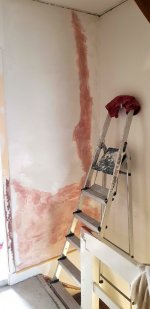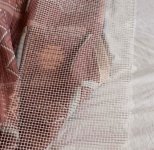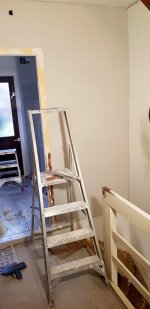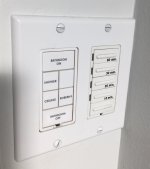You are using an out of date browser. It may not display this or other websites correctly.
You should upgrade or use an alternative browser.
You should upgrade or use an alternative browser.
Alex's Major Home Improvement Thread
- Thread starter AlexThePalex
- Start date
AlexThePalex
Member
- Joined
- Nov 12, 2008
- Messages
- 7,757
Bob D. said:Curious, what was used before plastic device boxes were available?
Metal. Been outlawed now for over 45 years here. You still find them in older houses, including mine, there are a few in the ceiling. That's how they installed them since before the war. Older wires also used to have cloth insulation instead of plastic like now. That cloth insulation would deteriorate and electrify the entire conduit system. They sure knew how to make it in the early days. [tongue]
DeformedTree
Member
- Joined
- May 19, 2018
- Messages
- 1,341
So ground wire thru everything has been mandated since the 60s (before then, it was only on a few items like bathroom plugs). We have plastic and metal boxes, also fiberglass and other materials too. Plastic has become common in residential, but in commercial side almost everything is metal. You don't just have metal boxes, you have metal conduit (Rigid, EMT, BMC). This is often running thru metal studs.
Big issue with the plastic boxes is they are generally junk. They flex, they break, they have stupid bent tab thing for holding the wire, and they are terrible for threading the screws into on the receptacles/switches, etc. Verses the metal boxes where everything threads nice, they are solid, no concern over them getting smashed. Also you get into things like hanging ceiling fans off you need a metal box for that. Someone could make a better box for sure, but the economics of it would make it a failure. Soon as it cost more than metal, people will just buy the metal box. You go to a hardware store and you can probably find 5 different non-metalic boxes (blue plastic, heavy duty blue plastic, fiberglass, white ones made out of something, black ABS based ones, etc). Everyone trying to make a better plastic box, and they still are all terrible. Steel ones have issues to, but not so bad.
Some features of metal may exist in plastic, just not common. Like gangable boxes where you can just keep adding gangs to them.
Also remember the layout setup of our switches and plugs is very different. You guys are based on a common circle, if you need 2 item next to each other, you just put another circle next to it. Our stuff is rectangles on a tight pitch. So every time you add a device, it's a different box, not just add on, unless you have the gangable option. While it makes things tight, it has a benefit that if you have say 5 light switches in a row, it doesn't take up much space, where with the European style boxes you would be half way down the wall.
With all the applications where metal is mandated, they aren't going anyplace. I'm curious what happens in an industrial environment over there. Here its all metal conduit, metal boxes. Giant racks of the stuff. What do you use outside where you will have UV exposure? Or don't want to have it shatter when something hits it in the middle of winter?
The other thing on the ground is the "what if" situation. What if someone wants to later have a switched plug in that circuit. What if the fixture being mounted up has a ground since it's a metal frame, thus has potential to be energized. You never know what can happen in time to a circuit in the form of damage too.
I think most folks who have done electrical work here would agree, the north American junction boxes general suck, and having there being so many different shapes and sizes is a big issue, but I don't think anyone is looking to get rid of metal boxes. I'd be fine if the plastic ones went away.
Are your light switches all plastic? Ours have ground screws on them.
Big issue with the plastic boxes is they are generally junk. They flex, they break, they have stupid bent tab thing for holding the wire, and they are terrible for threading the screws into on the receptacles/switches, etc. Verses the metal boxes where everything threads nice, they are solid, no concern over them getting smashed. Also you get into things like hanging ceiling fans off you need a metal box for that. Someone could make a better box for sure, but the economics of it would make it a failure. Soon as it cost more than metal, people will just buy the metal box. You go to a hardware store and you can probably find 5 different non-metalic boxes (blue plastic, heavy duty blue plastic, fiberglass, white ones made out of something, black ABS based ones, etc). Everyone trying to make a better plastic box, and they still are all terrible. Steel ones have issues to, but not so bad.
Some features of metal may exist in plastic, just not common. Like gangable boxes where you can just keep adding gangs to them.
Also remember the layout setup of our switches and plugs is very different. You guys are based on a common circle, if you need 2 item next to each other, you just put another circle next to it. Our stuff is rectangles on a tight pitch. So every time you add a device, it's a different box, not just add on, unless you have the gangable option. While it makes things tight, it has a benefit that if you have say 5 light switches in a row, it doesn't take up much space, where with the European style boxes you would be half way down the wall.
With all the applications where metal is mandated, they aren't going anyplace. I'm curious what happens in an industrial environment over there. Here its all metal conduit, metal boxes. Giant racks of the stuff. What do you use outside where you will have UV exposure? Or don't want to have it shatter when something hits it in the middle of winter?
The other thing on the ground is the "what if" situation. What if someone wants to later have a switched plug in that circuit. What if the fixture being mounted up has a ground since it's a metal frame, thus has potential to be energized. You never know what can happen in time to a circuit in the form of damage too.
I think most folks who have done electrical work here would agree, the north American junction boxes general suck, and having there being so many different shapes and sizes is a big issue, but I don't think anyone is looking to get rid of metal boxes. I'd be fine if the plastic ones went away.
Are your light switches all plastic? Ours have ground screws on them.
Cheese
Member
Really nice job on the plaster ceiling Alex...my arms get tired by just looking at it.
Curious about the small step-up at the bathroom door, is that just for the bathroom only?
Plastic vs metal boxes...that's funny as I always install a metal box. The only exception is I installed a couple of plastic boxes in the bathroom where I was concerned about possible RF signal mitigation when I installed some Insteon RF switches and relays.
https://www.smarthome.com/collectio...keypad-dimmer-switch-dual-band-6-button-whitehttps://www.smarthome.com/collections/insteon-switches/products/insteon-2443-222-micro-on-off-module
[attachimg=1]
Curious about the small step-up at the bathroom door, is that just for the bathroom only?
Plastic vs metal boxes...that's funny as I always install a metal box. The only exception is I installed a couple of plastic boxes in the bathroom where I was concerned about possible RF signal mitigation when I installed some Insteon RF switches and relays.
https://www.smarthome.com/collectio...keypad-dimmer-switch-dual-band-6-button-whitehttps://www.smarthome.com/collections/insteon-switches/products/insteon-2443-222-micro-on-off-module
[attachimg=1]
Attachments
danny l
Member
- Joined
- Feb 2, 2021
- Messages
- 14
DeformedTree said:Alex said:DeformedTree said:You don't have ground/earth wire thru everything? Fixture bases included?
You can put a ground wire on a lamp if you want to, but it is not mandatory. The ground wire can have its use if the lamp has a metal base, but a lamp's base can be made out of any material including non-conductive materials like plastic or wood.
Even ignoring the base, it's just hard to see there not being a mandate for a ground wire thru everything. Here all circuits must have ground wire. Thus all multi-wire cable you buy has a ground wire in it. Any place it meets metal along the way, it gets bonded, such as anytime a metal junction box (pattress box) is used.
It is mandatory in the netherlands as well. But this is only for about 25 years now. So older houses have only ground wire in wet rooms. But you should put ground wire to every lamp, socket or what so ever when changing the electrical system. That is a rule lots of people don't know.
AlexThePalex
Member
- Joined
- Nov 12, 2008
- Messages
- 7,757
danny l said:It is mandatory in the netherlands as well. But this is only for about 25 years now. So older houses have only ground wire in wet rooms. But you should put ground wire to every lamp, socket or what so ever when changing the electrical system. That is a rule lots of people don't know.
Since you seem to be so certain about hese rules, may I ask what your daytime profession is?
Would be nice of you were actually correct. But you try to correct me on two things and you're wrong on both.
What is mandatory here in the Netherlands since 1996 is that sockets must always be grounded in new installations and renovations. There is no such rule about lamps, and most certainly not in OLDER houses like mine.
I could put a ground wire in that little piece of conduit if I wanted, I have no problem with that at all, but there is simply no wire to connect it to unless I install a totally new one from the main switch board myself.
AlexThePalex
Member
- Joined
- Nov 12, 2008
- Messages
- 7,757
DeformedTree said:Big issue with the plastic boxes is they are generally junk.
Someone could make a better box for sure, but the economics of it would make it a failure.
Someone did make a better box and decided to sell it here. The junction boxes used in a home typically cost 2 to 4 euros, so not a big deal.
DeformedTree said:I'm curious what happens in an industrial environment over there. Here its all metal conduit, metal boxes. Giant racks of the stuff. What do you use outside where you will have UV exposure? Or don't want to have it shatter when something hits it in the middle of winter?
They are metal or plastic. I don't know what your concern is with plastic, there are litterally thousands of types of plastic, and some are very tough. PVC is often used, and that is not an expensive material yet very durable.
DeformedTree said:What if someone wants to later have a switched plug in that circuit. What if the fixture being mounted up has a ground since it's a metal frame, thus has potential to be energized.
Sorry, that's their problem. They want to change the electrical system? Fine, they make it suitable for their needs, not me. I make it suitable for my needs. BY the rules.
DeformedTree said:I think most folks who have done electrical work here would agree, the north American junction boxes general suck
Well, stop making them suck then.
DeformedTree said:Are your light switches all plastic? Ours have ground screws on them.
Our switches do not have a way to ground them. Our switches generally exist out of a plastic inner core where the switching happens. All electrical components are totally enclosed, in there, there is no way to even touch electricity with your fingers. Then around that plastic core there is a metal frame to mount the switch in the plastic wall box. The metal frame is, again, totally isolated from any electrical parts.
I will install these switches from the German quality brand Gira.

Last edited:
AlexThePalex
Member
- Joined
- Nov 12, 2008
- Messages
- 7,757
danny l said:The first working years as an electrician. The last 23 years i am working as a drywall specialist.
23 years as a drywall specialist, but you were not aware that you can plaster over it if you prime it?
AlexThePalex
Member
- Joined
- Nov 12, 2008
- Messages
- 7,757
Cheese said:Curious about the small step-up at the bathroom door, is that just for the bathroom only?
You mean this?

My father made it like that to contain water inside the bathroom. Wet spaces here generally have raised thresholds as a dam.
I do not like it like this, it is flimsily done with tiles like this. I plan on putting a basalt threshold in.

Cheese said:Plastic vs metal boxes...that's funny as I always install a metal box. The only exception is I installed a couple of plastic boxes in the bathroom where I was concerned about possible RF signal mitigation when I installed some Insteon RF switches and relays.
Sometimes I think you Americans are odd fellows. 120 volt because it supposedly is safer than 240, but then you built it inside conductive metal instead of insulating plastic.
Last edited:
AlexThePalex
Member
- Joined
- Nov 12, 2008
- Messages
- 7,757
The wall between the bathroom and the upper hallway also needed some work. This was the worst wall of all in the house, but I forgot to make a before picture here. Where you see that red snake of primer crawl up the wall, there was a huge crack in the bricks that ran from top to bottom.
My neighbour said his house had that exact same crack in the exact same spot, so it must be an original design flaw when they built these houses.
My father already patched it with cement back in 1972, but most of that had crumbled by now and it all just came down when I removed the wallpaper that was over it. Most of the original plaster also came down.
Luck had it I was working on a job were we had a mason building a kitchen extension, and I asked him how I could solve this best. He went to his van and he came back with some special concrete cement that had special fibers in it so it remained flexible when cured. He told me how it was called, but I forgot, this was over a year ago. This stuff was especially developed for these kind of cracks. I applied it and so far I have not seen the crack re-appear.

I used this wall to smear out the left overs I had from other jobs so it was already filled for the most, but now it was time to apply the final layer.
When you plaster over a crack, you should place some netting, which is basically the same stuff as the mesh tape you put over drywall seams.

First a small layer of plaster as glue, and then you press it in.

And all done.

My neighbour said his house had that exact same crack in the exact same spot, so it must be an original design flaw when they built these houses.
My father already patched it with cement back in 1972, but most of that had crumbled by now and it all just came down when I removed the wallpaper that was over it. Most of the original plaster also came down.
Luck had it I was working on a job were we had a mason building a kitchen extension, and I asked him how I could solve this best. He went to his van and he came back with some special concrete cement that had special fibers in it so it remained flexible when cured. He told me how it was called, but I forgot, this was over a year ago. This stuff was especially developed for these kind of cracks. I applied it and so far I have not seen the crack re-appear.

I used this wall to smear out the left overs I had from other jobs so it was already filled for the most, but now it was time to apply the final layer.
When you plaster over a crack, you should place some netting, which is basically the same stuff as the mesh tape you put over drywall seams.

First a small layer of plaster as glue, and then you press it in.

And all done.

Last edited:
DeformedTree
Member
- Joined
- May 19, 2018
- Messages
- 1,341
Alex said:DeformedTree said:Are your light switches all plastic? Ours have ground screws on them.
Our switches do not have a way to ground them. Our switches generally exist out of a plastic inner core where the switching happens. All electrical components are totally enclosed, in there, there is no way to even touch electricity with your fingers. Then around that plastic core there is a metal frame to mount the switch in the plastic wall box. The metal frame is, again, totally isolated from any electrical parts.
I will install these switches from the German quality brand Gira.
[attachimg=1]
So our switches don't have metal you touch either. But like yours there is the metal around it. We call it a Yoke here. That gets grounded. You never know what will happen to cause something to get energized. Also since switch covers are often metal, it's the ground path for the cover. Thus with a bare copper wire running thru the whole system and every bit of metal connected to it, no matter what happens, you have a return path that isn't you.
I've been trying to find more on your electrical there, but it's hard since search engines want to show north American results, type in Netherlands and google will return results with Netherlands scratched out. Get some stuff on the UK, but they (ignoring their whole ring bus issue) basically do things the same as N.A. and use similar hardware, their metal boxes look almost identical to ours. Maybe there is a "Stanley: How to wire your house, Netherlands Edition" Book.
DeformedTree
Member
- Joined
- May 19, 2018
- Messages
- 1,341
Alex said:Sometimes I think you Americans are odd fellows. 120 volt because it supposedly is safer than 240, but then you built it inside conductive metal instead of insulating plastic. [blink]
Lower voltage, harder to get an arc going, harder to overcome the bodies resistance and send power thru the person.
Metal boxes/conduits is safer because the system always has a defined return/ground path. If you don't, and do everything plastic you have to hope that they system always maintains that isolation and nothing goes wrong. You can't plan for everything that can happen, so by having the ground paths, you have covered anything that could happen, even if you could never imagine it. No real different than things like GFCI (ground fault), you shouldn't be standing in water drop a toaster in with you, but it's there just incase. Or AFCI (arc fault), your wiring shouldn't have an issue, but you never know if someone will manage to send something thru a wire, or the wiring just gets old and brittle after 100 years and looses it's insulation. Also it gives a path for static discharge.
Regions like Chicago are metal for everything, no Romex wiring. They had a "fire incident a while back" and take no chances.
Anything fails in a system with metal boxes, metal conduit, it has a return path, and any fire created in the moment can't get anyplace.
AlexThePalex
Member
- Joined
- Nov 12, 2008
- Messages
- 7,757
ROFL, you're really fond of electricity, aren't you? I'm not getting drawn into a discussion about it like you had with Coen. I don't care, I'm just fixing up the house. 
Last edited:
DeformedTree
Member
- Joined
- May 19, 2018
- Messages
- 1,341
Alex said:ROFL, you're really fond of electricity, aren't you? I'm not getting drawn into a discussion about it like you had with Coen. I don't care, I'm just fixing up the house. [tongue]
I thought you were ridding the old world of wallpaper [tongue]
Sparktrician
Member
Alex said:Sometimes I think you Americans are odd fellows. 120 volt because it supposedly is safer than 240, but then you built it inside conductive metal instead of insulating plastic. [blink]
BA-HAHAHAHA!!!! Leave it to you, Alex, to point out the obvious! [big grin]
AlexThePalex
Member
- Joined
- Nov 12, 2008
- Messages
- 7,757
DeformedTree said:I thought you were ridding the old world of wallpaper [tongue]
Quite right, and my holy mission is daunting enough as it is without getting distracted by ground wires in metal boxes.
Last edited:
DeformedTree
Member
- Joined
- May 19, 2018
- Messages
- 1,341
Alex said:DeformedTree said:I thought you were ridding the old world of wallpaper [tongue]
Quite right, and my holy mission is daunting enough as it is without getting distracted by ground wires in metal boxes. [smile]
Just want you safe when you go chewing on wires.
I pity any door to door wall paper salesman knocking on your door.
As you master plaster, when can we expect you to start doing a fresco on a wall?
Cheese
Member
Alex said:1. You mean this?
2. Sometimes I think you Americans are odd fellows. 120 volt because it supposedly is safer than 240, but then you built it inside conductive metal instead of insulating plastic. [blink]
1. Yup
2. Unfortunately, I've had the bad experience of grabbing 120V several times, and while not debilitating, it certainly got my attention.
More importantly, on one of those occasions the 120V grab prevented me from releasing the trigger on the circular saw, and I was only able to cut the juice when I ripped the extension cord from the wall because my fingers were still wrapped around the trigger switch.
I can only imagine what the outcome of that adventure would have been if i was hooked up to 240V.
On another note, as DeformedTree said, the plastic boxes in the US are horrific. Totally trash. They come with a pair of 14/16 penny nails that are supposed to secure it to the wooden studs...NOT.
Junk...Junk...Junk
The boxes flex, they move, the internal threads strip out, Junk...Junk...Junk
While the steel boxes can be attached with #9 or #10 screws and will last a life time. Besides, we can attach a ground wire to them and feel safe. [poke]
AlexThePalex
Member
- Joined
- Nov 12, 2008
- Messages
- 7,757
Cheese said:More importantly, on one of those occasions the 120V grab prevented me from releasing the trigger on the circular saw, and I was only able to cut the juice when I ripped the extension cord from the wall because my fingers were still wrapped around the trigger switch.
I can only imagine what the outcome of that adventure would have been if i was hooked up to 240V.
I've had countless shocks from 240 by now. Not one of them ever bothered me a bit.
But getting zapped with a running circular saw in your hands, how did you accomplish that? Glad you weren't hurt.
Similar threads
- Replies
- 22
- Views
- 2K
- Replies
- 6
- Views
- 375
- Replies
- 15
- Views
- 1K

